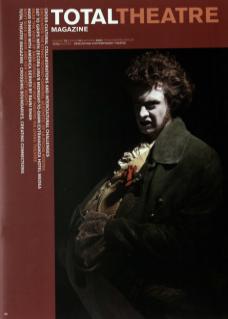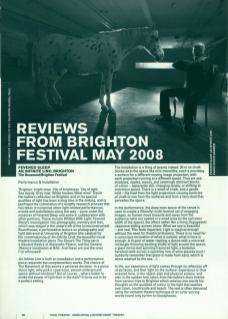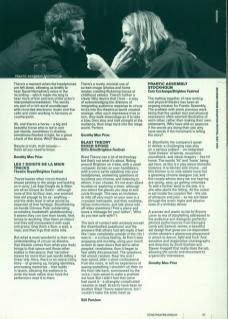‘Brighton: bright town. City of brightness. City of light. Sea dazzle. Grey mist. White houses. West wind.' David Harradine's reflection on Brighton and on its special qualities of light has been a long time in the making, and is (perhaps) the culmination of a lengthy research process that has taken in numerous other light-related performances, events and installations along the way – some under the auspices of Fevered Sleep and some in collaboration with other partners. These include Written With Light, Fevered Sleep's investigation into photography, memory and loss, which was staged in the undercroft of the (unreconstructed) Roundhouse, a performative lecture on photography and light delivered at University of Brighton (the catalyst for the commissioning of An Infinite Line); the beautiful visual theatre/installation piece The Show's The Thing set in a disused theatre at Alexandra Palace; and the Camera Obscura installation at BAC. And these are just the ones I've witnessed!
An Infinite Line is both an installation and a performance piece; separate but complementary works. The choice of The Basement at first seems a perverse decision. In a piece about light, why pick a cavernous, almost-underground space without windows? But of course – where better to evoke the power of light than in the dark? It turns out to be a perfect setting.
The installation is a thing of beauty indeed: 30 or so chalk blocks sit in the space like mini-monoliths, each a providing a surface for a different moving image projection; with each projection running at a different speed. Thus we see shadows, ripples, waves, and seemingly abstract blocks of colour – apparently still, changing slowly, or shifting at enormous speed. There is a smell of chalk, and a gentle mist – the heat from the light projections causing particles of chalk to rise from the surfaces and form a fairy-dust that pervades the space.
In the performance, the deep main space of the venue is used to create a (literally) multi-layered set of engaging images, as frames move towards and away from the audience (who are seated in a small area on the narrower width of the space), the effect rather like a living Dogugaeshi Japanese sliding-screen show. What we see is beautiful – and real. This feels important. Light is magical enough without the need for theatrical illusions.
There is no need for a conscious recreation of what is outside; what is here is enough. A lit pool of water rippling; a dance with a mirrored rectangle throwing dazzling shafts of light around the space; a giant mirror-ball spinning fractured light; a tentative barefoot walk across a sparkling row of wine glasses (and I suddenly remember that glass is made from sand, which is stone washed by the sea...).
In life, our experience of light comes through its reflection off of surfaces, and that 'light on the surface' experience is thus enacted here, in the object-play and physical actions, and also in the spoken text, taken from Harradine's diary entries from various trips to Brighton which weaves into words his thoughts on the qualities of colour in the light that washes over town, countryside and beach. The text is often delivered using the verbatim theatre technique of an actor voicing words heard only by him on headphones.
There's a moment when the headphones are left down, allowing us briefly to hear David Harradine's voice in the recording – which made me long to hear more of him and less of the actor's interpretation/mediation. The words are part of a rich aural soundscape with recorded electronic music and live cello and violin working in harmony or counterpoint
Oh, and there's a horse – a big and beautiful horse who is led in and just stands, sometimes in shadow, sometimes flooded in light, for a great chunk of the show. Why? Because.
Beauty is truth, truth beauty – that's all you need to know.


